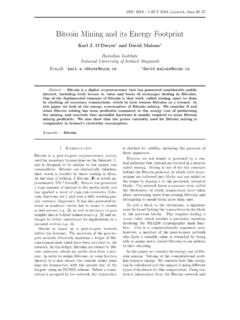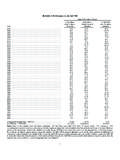Transcription of Recent Development in Transformer Winding …
1 Recent Development IN Transformer Winding TEMPERATURE DETERMINATIONJean-No l B rub , Jacques AubinW. McDermidNeoptix HydroLoading capability of power transformers is limited mainly by Winding temperature. As part of acceptance tests on new units, the temperature rise test is intended to demonstrate that at full load and rated ambient temperature, the average Winding temperature will not exceed the limits set by industry standards. However the temperature of the Winding is not uniform and the real limiting factor is actually the hottest section of the Winding commonly called Winding hot spot. This hot spot area is located somewhere toward the top of the Transformer , and not accessible for direct measurement with usual temperature of solid insulation is the main factor of Transformer aging.
2 With temperature and time, the cellulose insulation undergoes a depolymerization process. As the cellulose chain gets shorter the mechanical properties of paper such as tensile strength and elasticity degrades. Eventually the paper become brittle and is not capable of withstanding short circuit forces and even normal vibrations that are part of Transformer life. This situation characterizes the end of life of the solid insulation. Since it is not reversible, it also defines the Transformer end of life. This process is well known to Transformer owners and sustained efforts have been made to monitor the hot spot temperature to take advantage of cool ambient temperature, extend the Transformer life while providing emergency overloading capabilities and taking advantage of market opportunities.
3 Figure 1 shows the sensitivity of paper to temperature. Modern transformers make use of thermally upgraded paper that has been chemically treated to improve the stability of cellulose structure. The rated hot spot temperature for this kind of paper is 110 C and it can be seen that an increase of 7 C will double the aging acceleration factor. For older Transformer build with normal Kraft paper, the rated hot spot temperature is either 95 C according to IEEE or 97 C according to IEC. This paper is also very sensitive to temperature and in case of emergency (assuming a hot spot temperature of 140 C) the aging acceleration factor is about 100, which means one hour in this condition is equivalent to 100 hours at the rated transformers (solid insulation showing more than 2% water content) incur an additional risk when operating at high temperature.
4 It has been shown that the residual water trapped in paper may reach bubbling conditions and escape from paper under the form of water vapor bubbles. These bubbles may move with the oil flow, or get trapped in the Winding and in both cases create a threat for insulation breakdown. No wonder that the Transformer operator attempts to control the Winding hot spot temperature with the best mean 1 Effect of temperature on paper aging rateRecent Development on Winding temperature calculation methodsFor several decades IEEE and IEC loading guides (1,2) have been providing guidelines for the calculation of the Winding hottest spot temperature from data that can be conveniently measured and parameters derived from temperature rise test or manufacturer calculations.
5 The basic calculation method relies on the measurement of oil temperature at the top of the Transformer tank (top-oil temperature) and a calculation of the temperature difference between the Winding hottest spot and the top oil. This temperature rise is provided by the manufacturer, based on his modeling of oil flow and losses distribution in the Winding . Thereafter the hot-spot temperature can be computed for any load using the standard relation: Where: HS = Hot-spot temperature TO =Top-oil temperature HR=Rated hot-spot temperature rise above top oil I =Load current IR =Rated current m = Winding exponent temperatureAging Acceleration FactorNormal Kraft (IEEE)Normal Kraft (IEC)Thermally Upgraded PapermRHRTOHSII2 + = This simple formula was completed with an exponential function to account for the thermal inertia of the Winding when a sudden load increment is applied.
6 This calculation method has been around for several decades but a more frequent utilisation of Transformer overload capability has shown the inadequacy of this approachA revision of the loading guide for power transformers is currently in progress. It is noted that the traditional hot-spot temperature calculation method uses a number of assumptions that are not correct: Oil temperature in the cooling duct is assumed to be the same as the top oil temperature The change in Winding resistance with temperature is neglected The change in oil viscosity with temperature is neglected The effect of tap position is neglected The variation of ambient temperature is assumed to have an immediate effect on oil , experimental work has shown that at the onset of a sudden overload, oil inertia induces a rapid rise of oil temperature in the Winding cooling ducts that is not reflected by the top oil temperature in the tank.
7 Therefore alternate sets of equations are being developed, taking into account all these additional important evolution is the disappearance of the guide on definition of Transformer Thermal Duplicate that was often used to provide default values for Winding temperature rise at rated load (3). This reference will not be available anymore to provide support to the hot-spot temperature rise estimated by the manufacturer. This might reduce the credibility of Transformer manufacturer in providing that critical thermal approachA new edition on the loading guide as recently been published (2). It is now more clearly stated that the H factor relating the average Winding to oil gradient to the hot-spot to top oil gradient can vary over a wide range depending on Transformer size impedance and design.
8 Here again the correct calculation of the critical temperature difference between Winding hottest spot and top oil will depend on manufacturer ability to model properly the oil flow within the Winding ducts, the distribution of losses along the Winding , the heat transfer characteristics of the various insulation thickness used throughout the Winding and the impact of local features restricting the oil is also recognized that the dynamic response of the previous calculation method is not adequate as a sudden increase in load current may cause an unexpected high peak in the Winding hot-spot temperature. To cover all type of load variations, an elaborate set of differential equations is provided, taking account of the Winding thermal time constant, the oil time constant and three new constants to characterize the oil flow.
9 3 Fig. 2 Block diagram of IEC differential equation model for hot spot determination under dynamic loading conditionsAll these changes in IEEE and IEC loading guides indicate that hot-spot temperature calculation methods previous known were not adequate to assess accurately Winding hot-spot temperature. Wide use of computers now allows for sophisticated calculation methods but it demonstrates that the quest of Winding hot-spot temperature is not trivial and it raises new doubts considering the number of additional values that need to be collected to run the calculation. No wonder that the direct measurement of Winding temperature with fiber optic sensors is the recommended practice for critical transformers (2,4,5). Recent Development on direct measurement of Winding hot-spot temperatureFor nearly thirty years, fiber optic temperature sensors have been available for measurement in high voltage Transformer .
10 First units were fragile and needed delicate handling during manufacturing. Over the past ten year significant Development took place to improve ruggedness and facilitate connection through tank fiber optic probe on the Neoptix T/Guard system consists of a 200-micron solid state optical fiber sheathed with a permeable protective PTFE Teflon sheath. This probe is designed to withstand manufacturing conditions including kerosene desorption as well as long term immersion in Transformer oil. Permeability of the Teflon jacket allows for full impregnation under vacuum. The temperature-sensing element is based on the proven GaAs technology and is driven with an original algorithm to analyze the signal and provide repeatable and reproducible order to measure Winding temperature, the sensor can be embedded in a spacer or attached directly onto any conductor that deserves temperature monitoring.







